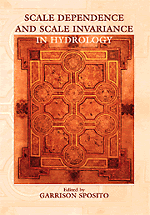Book contents
- Frontmatter
- Contents
- List of Contributors
- Preface
- 1 Scale Analyses for Land-Surface Hydrology
- 2 Hillslopes, Channels, and Landscape Scale
- 3 Scaling in River Networks
- 4 Spatial Variability and Scale Invariance in Hydrologic Regionalization
- 5 An Emerging Technology for Scaling Field Soil-Water Behavior
- 6 Scaling Invariance and the Richards Equation
- 7 Scaling of the Richards Equation and Its Application to Watershed Modeling
- 8 Scale Issues of Heterogeneity in Vadose-Zone Hydrology
- 9 Stochastic Modeling of Scale-dependent Macrodispersion in the Vadose Zone
- 10 Dilution of Nonreactive Solutes in Heterogeneous Porous Media
- 11 Analysis of Scale Effects in Large-Scale Solute-Transport Models
- 12 Scale Effects in Fluid Flow through Fractured Geologic Media
- 13 Correlation, Flow, and Transport in Multiscale Permeability Fields
- 14 Conditional Simulation of Geologic Media with Evolving Scales of Heterogeneity
- Index
8 - Scale Issues of Heterogeneity in Vadose-Zone Hydrology
Published online by Cambridge University Press: 18 January 2010
- Frontmatter
- Contents
- List of Contributors
- Preface
- 1 Scale Analyses for Land-Surface Hydrology
- 2 Hillslopes, Channels, and Landscape Scale
- 3 Scaling in River Networks
- 4 Spatial Variability and Scale Invariance in Hydrologic Regionalization
- 5 An Emerging Technology for Scaling Field Soil-Water Behavior
- 6 Scaling Invariance and the Richards Equation
- 7 Scaling of the Richards Equation and Its Application to Watershed Modeling
- 8 Scale Issues of Heterogeneity in Vadose-Zone Hydrology
- 9 Stochastic Modeling of Scale-dependent Macrodispersion in the Vadose Zone
- 10 Dilution of Nonreactive Solutes in Heterogeneous Porous Media
- 11 Analysis of Scale Effects in Large-Scale Solute-Transport Models
- 12 Scale Effects in Fluid Flow through Fractured Geologic Media
- 13 Correlation, Flow, and Transport in Multiscale Permeability Fields
- 14 Conditional Simulation of Geologic Media with Evolving Scales of Heterogeneity
- Index
Summary
Introduction
The hydrologic properties of the vadose zone often exhibit high degrees of spatial variability over a range of scales because of the heterogeneous nature of geologic formations. For laboratory-scale problems (i.e., small cores, soil columns, and sand-boxes), variations in pore size, pore geometry, and tortuosity of pore channels are the major sources of heterogeneity. They are called laboratory-scale heterogeneities. Microstratification, foliation, cracks, and roots are also some possible heterogeneities at this scale. As our problem scale increases to that of a field, stratification or layering in a geologic formation becomes the dominant heterogeneity, often classified as field-scale heterogeneity. At an even larger problem scale, regional-scale heterogeneity consists in variations in geologic formations or facies. Variations among sedimentary basins are then categorized as global-scale heterogeneities.
The fundamental theories for flow and solute transport through porous media have essentially been derived for laboratory-scale heterogeneities. When we attempt to apply these theories to the vadose zone, comprising heterogeneities on many different scales, we encounter a scale issue. That is, these theories, suitable for the laboratory-scale problem, may not be applicable to problems at other scales. To deal with this issue, two approaches have evolved: the systems approach and the physical approach. The systems approach treats the vadose zone as a low-pass filter, and its governing principle is determined by the relationship between its input and output histories (e.g., Jury, Sposito, and White, 1986). The physical approach relies on the upscaling of laboratory-scale theories to the vadose zone.
- Type
- Chapter
- Information
- Scale Dependence and Scale Invariance in Hydrology , pp. 224 - 265Publisher: Cambridge University PressPrint publication year: 1998
- 22
- Cited by



